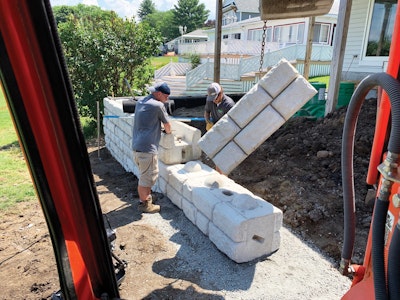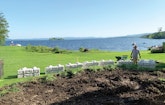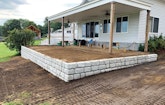
When the deck was rebuilt at the home on Great Sacandaga Lake, the builder installed hatches so technicians can service the Singulair Green tank below the deck. (Photos courtesy Adirondack Septic Tank)
The story is familiar. A lake house built in the 1940s needed a new onsite system. But the situation that technicians from Adirondack Septic Tank faced was a challenge.
With some creative design and installation, the house now has a new onsite system, but it took care to make everything fit. The entire system is under a deck, the only space available on a lot measuring about 128 feet by 56 feet, mostly covered by the house, and on the shore of Great Sacandaga Lake in New York state’s Adirondack Park.
System
Wastewater leaves the east side of the house in a 4-inch Schedule 40 PVC pipe that runs about 25 feet and makes two 45-degree bends to line up with the inlet of a Norweco Singulair Green unit. There was about 4 feet of space between the east house wall and the property boundary, and this is where the influent line had to fit.
From the Norweco tank, water flows about 3 feet to a Norweco AT 1500 UV unit. No pumping is used in the system. The grades and pitches worked out so flow through the entire system could be done with gravity, says Jeff Zielinski, project manager for Adirondack Septic.
Another run of 4-inch pipe takes water to a sand bed for the Presby Enviro-Septic dispersal system. Distance from UV treatment to the Presby bed distribution box was only 3 feet, but because of the positions of holes, water flows about 6 feet.
The box is a typical five-hole precast box, in this case from Miller’s Ready Mix & Block, with TUF-TITE speed levelers on the two outlet holes used for the Presby bed.
Enivro-Septic pipes were laid on a minimum 12 inches of sand, with more depth where the grade sloped, and there is about another 12 inches of sand on top. In total the sand bed was about 3 feet thick.
There are two sections of Presby pipe, each 60 feet in total, but they wind back and forth in three 20-foot runs to remain within the confines of the bed.
Equipment
To do the job, the Adirondack team used a Kubota KX121-3 mini-excavator with a hydraulic thumb and six-way blade, and a Kubota SVL75-2 tracked skid-steer.
A six-wheel 2006 International 8500 dump truck with a box by Godwin Mfg. brought in sand. The small truck was best suited to the 14-foot space between houses that was the only access for equipment and material. To keep everything accurate, the crew used a DeWALT DW073 laser level.
Challenges
The deck, 21-by-38-feet, is on the lake side of the house, and it was removed for the installation and rebuilt later. Over it was a porch roof that was not removed.
Operators had to take care as they worked under the roof. “There were instances when we had only inches to spare,” Zielinski says. “It was like a big game of Operation.
“Between two runs of the Presby lines, we had to nest in three 4-by-4 pressure-treated vertical posts for deck support,” Zielinski says. The builder hired to replace the deck advised on placement of the support posts so reconstruction wouldn’t disturb the Presby system, Zielinski says.
The crew leveled the existing soil and brought in about 22 yards of concrete sand for the Presby system bed. About another 8 yards filled gaps between system components and behind a new concrete block wall built to contain the system.
Installation of the Singulair was staged so house occupants were never without wastewater service. The Singulair was installed first and plumbed to the house. For a few days it acted as a holding tank until technicians remediated the old tank, built the Presby bed on top of it, and connected the Singulair unit to the Presby system.
The retaining wall was built of Redi-Rock. The wall starts on the east side of the house where the influent line exits, runs toward the lake and wraps around the end of the house. Technicians used 63 full blocks and two half blocks. Blocks measure about 18 inches tall, 23 inches deep and 46 inches long, and each weighs 1,100 to 1,400 pounds.
Like the wastewater system, the wall was built in stages. First technicians built the wall along the side of the house, installed the influent line, topped it with 2-inch insulation board, and backfilled. Next they installed the Singulair tank and built half of the front wall while backfilling. Then they built the Presby bed, finished the wall, backfilled around the Presby pipes and added the final loads of sand to match the height of the wall. Behind the wall they installed fabric to prevent seepage.
“There is no green space on the road side of the house,” Zielinski says. “There is road and then essentially blacktop to the garage.” Material was staged on the driveway and moved through the narrow space on the west side of the home. That also held a buried oil tank, so Zielinski’s crew laid standard 1-inch-thick steel road plates over it to prevent damage.
Another complication was the property line, which almost touches one corner of the house. Beyond that line, land belongs to the Hudson River-Black River Regulating District. The lake was created in the 1930s to help control flooding downstream in the Hudson River Valley. It is the board that owns the lake and the shore up to a certain point above high water, Zielinski says.
“You can’t put a shovel in the ground, basically, beyond their taking line,” he adds. “You certainly can’t put a septic over the taking line.”
Did the previous onsite system cross the line? “It probably did,” Zielinski says with a laugh.
Homes began appearing around Great Sacandaga Lake in the 1940s and without much regulation, he says. Many of the old systems were based on metal tanks or old oil tanks, and they discharged through pipes that ended somewhere in the soil.
Normally an installation requires about four days. This one, he says, took all or parts of about 12 days.
“This isn’t the first, and it certainly won’t be the last of these tight jobs,” Zielinski says. His company has a number of systems like this one going in around the lake to remediate systems from the 1940s and to help ensure that upstate New York’s treasured park remains clean.










